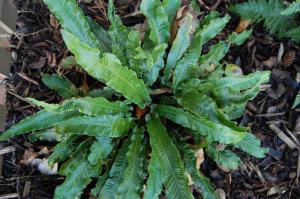
Asplenium scolopendrium (15/10/2011, London)
Position: Partial to full shade
Flowering period: None
Soil: Moist
Eventual Height: 50cm
Eventual Spread: 50cm
Hardiness: USDA Zones 5a-9b
Family: Aspleniaceae
Asplenium scolopendrium is an evergreen fern with a tufted growth habit. It has luscious green glossy, textured foliage, with undivided fronds, which are referred to as leaves. The leaves are 10 - 60 cm long and 3 -6 cm broad and are described as being tongue shaped and quite pinnate. On the underside of the leaves sori are arranged in rows perpendicular to the rachis and are clusters of sporangia structures, these produce spores.
A. scolopendrium, commonly known as Heart’s Tongue Fern, Horse Tongue Fern, Burnt Weed Fern or Buttonhole Fern, is synonymus with Phyllitis scolopendrium. It is native to Europe (including the UK), North Africa, North America and Asia. In the United States A. scolopendrium var. americanum was declared endangered in 1989. The European variety is relatively widespread.
The etymological root of the binomial name Asplenium is derived from the Greek a ‘without’ and splen ‘spleen’ i.e. ‘without a spleen’. Scolopendrium is derived from the Greek scolopendra ’centipede’ alluding to the rows of sori resembling a centipede.
The landscape architect find Asplenium scolopendrium useful in shady damp locations. It also suitable as part of a native woodland planting scheme.
A. scolopendrium prefers humus rich moist soils. It will tolerate most pH soils although it prefers neutral to lime rich soils. Once established it can tolerate dryer soils.
Asplenium scolopendrium has won the prestigious Royal Horticultural Societies annual Award of Garden Merit in 1993.
Maintenance: This plant requires little maintenance. Large clumps of this plant may be divided from March to May.

